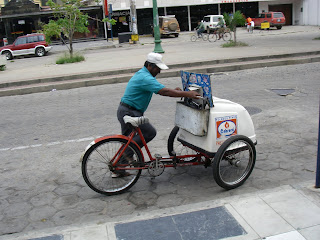One of the best parts of working at Olds College is that you can do some very interesting things if you are so inclined. During a recent survey class, Jack (my very talented Instructional Assistant) suggested that we let the students tackle a drainage problem for a new garden under construction. There was a CAD plan, and some work had been started, but Jack was suspicious that the work and the plan did not match. One quick measurement confirmed his fears; the plan did not fit in the restricted space provided. It seems that the plan was more of a suggestion—like traffic ‘laws’ in Sri Lanka. The discrepancy bothered me, mostly because I did not want to go and take a bunch of measurements. But what alternative was there?
Well, for starters we could get an air photo of the current situation, scale it and print it off for the students to work from, I thought. So I called my mentor, Murray, and we did just that. Now before you think colleges have money for renting airplanes at the whim of an instructor, I need to explain. Murray and I did a research project a few years back on portable remote sensing. The outcome of the project was a remote controlled aerial platform for taking pictures. It has proven very handy to answer questions such as "What is really there?" On this occasion it provided an added bonus.

A new garden feature under construction
It turned out that the fall colors where spectacular! I am not an artsy guy by nature, and those who know me know I have no talent at all, but even someone as artistically obtuse as I am was impressed at Mother Nature’s amazing canvas. It took about 20 minutes to get the pictures and an hour to decide which ones I wanted to keep. Another 30 minutes were required to get the data into the computer, scaled into a template, and ready to print. Another 15 minutes to repeat the whole process when my computer shut down and I realized I had not once saved…When will I ever learn?
Off to class I went, armed with the photos, laser levels, chains (tape measures), pins and other implements of destruction (sorry, flashing back to Alice’s Restaurant), and the students dug in. Now, I confess I see the world through slightly different glasses than most, but it warms the cockles of my heart to see Turf students measuring with chains and a plumb bob without any prodding from me. I was in such a good mood when I got back to my office that I thought I would share some of the pictures with everyone. I picked a few, saved them on our network, and sent an email to all students and employees of Olds College encouraging them to have a look at the beautiful shots.

The north orchard in fall splender
Now, I should know better than to send out a college-wide email, but I never learn. While I was getting emails to the effect of "great pictures," our IT department was getting emails to the effect of "why can’t I see those pictures?" It turns out that there is not a single network location that is accessible to everyone at Olds College. This made me think: isn’t it interesting that at a learning institution there is no single location within our network for collaboration between students, staff and faculty? Yes, the network provides space for virtual get-togethers between any two of the three groups, but not all. It is not that there couldn’t be space, there just wasn’t…yet.

Olds College from the North West
So where do we collaborate? Students collaborate on facebook, Second Life, the residence lounge, and in the back of my class. Faculty collaborates in the staff room, at lunch, or in the hall between offices. We collaborate at conferences, or after meetings—sometimes even during a meeting—but true collaboration, global collaboration, does require a whole new set of tools. I don’t have them yet, but I am willing to try. This blog is a start. My web guru emailed and said "Why didn’t you just put them on Flickr?" I don’t have a good answer for that, but next time I will give it a shot. Every time I think I am being wildly creative, I discover that, in fact, I am only being mildly creative. There is always more to learn, and there is always a better faster way to do it. The day I think I have it all figured out will be the day I know dementia has set in.

Looking South West across Olds
This is the closest I get to artsy shots. Enjoy the beauty that only Mother Nature can serve up. And watch for a Picasa photo album coming your way.



















